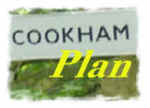
The Cookham Plan
Findings and Recommendations
Housing and Development Group
3. TOWN PLANNING
| MAIN REPORT INDEX | HOUSING AND DEVELOPMENT INDEX |
3 TOWN PLANNING
3.1 Remit
Review the built environment in Cookham, where and in what form future development should be permitted or prohibited, and how well the planning system works to meet residents' views and needs.
3.2 Issues and Concerns
Planning and development related matters are probably the most emotive subjects for people in Cookham. The village’s proximity to London, good transport links and the buoyant economy of the Thames Valley all provide strong demand for property and the consequential pressure for development threatens the special nature of the area that attracted many residents in the first place.
Many concerns related to housing and development matters were raised during the consultation process in the course of our preparation of this report. 644 households (over 25% of the total in Cookham) responded to the questionnaire issued by the Steering Committee and, where relevant, these responses have been taken into account by the Housing & Development Working Group. Key messages from the questionnaire included:
-
97% of respondents valued Cookham’s pleasant semi-rural nature (question 4)
-
95% agreed or strongly agreed that ‘the Cookhams should remain a semirural environment with a strictly limited increase in housing stock’ (question 8)
-
95% agreed or strongly agreed that ‘in general, the undeveloped open areas should be protected from development’ (question 8)
-
80% agreed or strongly agreed that ‘future house building in the Cookhams should concentrate on small scale in-filling within existing developed areas’ (question 8)
-
Responses to question 10 which asked about the acceptability of various types of development showed very strong bias against either larger groups of housing or expansion on the edge of Cookham The most important issues and concerns can be summarised as follows:
-
Green Belt
People value the Green Belt – they don’t want to lose the division between Cookham and Maidenhead – it is important to them to maintain the village status of the Cookhams.
-
Open space
People value the green space that exists within the villages and would be unhappy to see any of it disappear. This applies to both fields and commons and to gardens which are under pressure from infill development and increased development densities.
-
Mix of development
People are concerned about the increased numbers of flats being built and the lack of ‘affordable housing’. Residents would like to see more control of styling, size, number and type of housing and extensions.
-
Visibility of Planning Applications
Residents would like to see better engagement by the planning department of those affected by plans. Currently only immediate neighbours are notified of developments which often means that interested parties lose the opportunity to object.
-
Traffic concerns
There is no spare capacity for off-road parking in Cookham yet parking standards for new developments do not appear to recognise this. Similarly, the effect of new development on traffic volume and existing parking provision, particularly in Cookham Village and Cookham Rise do not seem to be given enough weighting.
-
Uneven balance between developers and residents
Large property owners or developers appear to have a disproportionate sway on what and where development can occur and this can have a big impact on the village environment. An example of this is developers’ ability to submit multiple applications and then wage what many see as a war of attrition until successful.
-
More effective enforcement from the Royal Borough of Windsor & Maidenhead (RBWM).
When things go wrong with new developments or regulations are broken, more than one planning department can be involved. There is an apparent lack of processes in place to ensure that issues are dealt with jointly and that the various council departments work together to resolve the problems.
In this section we will be looking at what makes the built environment in Cookham special, how it is currently protected and the preferred shape of future development.
3.3 The Built Environment
The Cookhams comprise Cookham Dean ; Cookham Rise, Cookham Village; and the surrounding green space between the River Thames and Maidenhead (as illustrated in Figure 3-1). Each of the villages is distinctive but as a whole they form an area which is much loved for its diversity and unique character.
According to the 2001 Census, Cookham Parish covers an area of 1,329 hectares and has a population of 5,497 people. There are 2,383 household spaces contained within 2,368 dwellings: 36% are detached, 49% semidetached or terraced and 15% are flats or temporary structures (such as mobile homes). 80% of dwellings are owner occupied, the rest are rented; 9% being public sector rentals and 11% private sector.